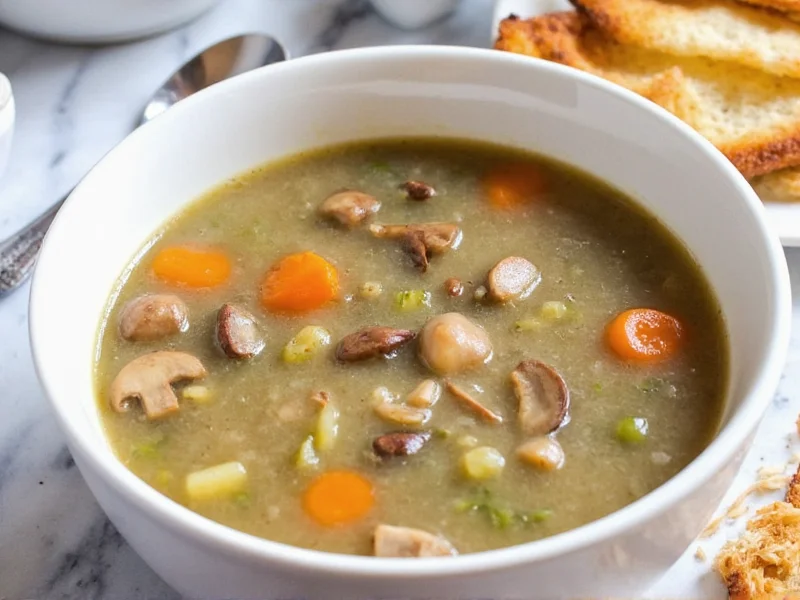Creating exceptional mushroom soup requires understanding the science behind flavor development. When mushrooms hit hot oil, the Maillard reaction creates complex umami compounds that form the soup's flavor foundation. This guide delivers five professionally tested mushroom soup recipes with precise techniques to maximize depth of flavor while avoiding common pitfalls like watery texture or muted mushroom taste.
Why Mushrooms Make Perfect Soup
Mushrooms contain natural glutamates that create rich umami flavor—nature's version of MSG. Different varieties offer unique profiles: cremini provide earthiness, shiitake add woodsy notes, and porcini deliver intense savoriness. Proper preparation unlocks these flavors through strategic moisture management and temperature control.
Essential Ingredients Guide
Quality ingredients make the difference between mediocre and magnificent mushroom soup. Here's what you need:
| Ingredient | Purpose | Pro Tip |
|---|---|---|
| Fresh mushrooms | Flavor foundation | Use 70% cremini + 30% shiitake for balanced depth |
| Dry sherry | Flavor enhancer | Add during sautéing to deglaze pan and capture fond |
| Fresh thyme | Aromatic complexity | Add whole sprigs during simmering, remove before blending |
| Homemade stock | Texture and body | Use mushroom or vegetable stock for vegetarian version |
Classic Creamy Mushroom Soup Recipe
This restaurant-quality mushroom soup recipe yields velvety texture without overwhelming creaminess. Serves 4.
Ingredients
- 1.5 lbs mixed mushrooms (cremini, shiitake), cleaned and sliced
- 3 tbsp unsalted butter
- 1 large yellow onion, finely diced
- 3 garlic cloves, minced
- 1/4 cup dry sherry
- 4 cups mushroom or vegetable stock
- 1 tbsp fresh thyme leaves
- 1/2 cup heavy cream
- Salt and white pepper to taste
Step-by-Step Instructions
- Dry sauté mushrooms: Heat large pot over medium-high. Add mushrooms in single layer without oil. Cook 8-10 minutes until moisture releases and evaporates. This concentrates flavor.
- Build flavor base: Remove mushrooms. Add butter to same pot. Sauté onions until translucent (5 min). Add garlic, cook 1 minute until fragrant.
- Deglaze: Pour in sherry, scraping browned bits from bottom. Simmer until liquid reduces by half.
- Simmer: Return mushrooms to pot. Add stock and thyme. Simmer covered 20 minutes.
- Blend: Carefully puree soup in batches until smooth. Return to pot.
- Finish: Stir in cream. Season with salt and white pepper. Simmer 5 more minutes.
Variations for Every Occasion
Vegan Mushroom Soup
Replace butter with olive oil and cream with 1/2 cup cashew cream. Add 1 tbsp nutritional yeast for umami boost. Simmer cashews with soup during final 10 minutes before blending.
Quick 30-Minute Version
Use pre-sliced mushrooms and vegetable broth. Skip the initial dry sauté—cook mushrooms directly in butter. Substitute 1 tsp dried thyme for fresh. Finish with coconut milk instead of cream.
Wild Mushroom Gourmet Soup
Use 50% cultivated mushrooms (cremini) and 50% dried wild mushrooms (porcini, morels). Rehydrate dried mushrooms in 2 cups hot water for 20 minutes. Use this flavorful liquid as part of your stock.
Healthy Low-Calorie Soup
Omit cream and thicken with pureed cauliflower. Use mushroom stock made from stems. Add 1 tbsp lemon juice at the end for brightness without extra calories.
Pro Tips for Perfect Mushroom Soup
- Avoid watery soup: Never add mushrooms to cold oil—they'll release water immediately. Always heat pan first.
- Maximize flavor: Save mushroom stems for stock. Simmer with onion peels and herb scraps.
- Texture control: For creamy but not heavy soup, blend only half the mixture and stir back into whole pieces.
- Salt timing: Add salt after mushrooms release their moisture to prevent drawing out too much liquid.
Troubleshooting Common Issues
Problem: Soup tastes bland
Solution: Add 1 tsp soy sauce or 1/4 cup grated Parmesan during simmering. Acid balances flavor—try 1 tbsp lemon juice or sherry vinegar at the end.
Problem: Soup is too thin
Solution: Simmer uncovered 5-10 minutes to reduce. Alternatively, make a slurry with 1 tbsp cornstarch and 2 tbsp cold water.
Problem: Mushrooms turned rubbery
Solution: You likely overcrowded the pan. Cook in batches with proper spacing for even browning.
Serving Suggestions
Elevate your mushroom soup with these professional touches:
- Top with truffle oil and fresh chives for gourmet presentation
- Pair with crusty bread and a simple arugula salad
- Add protein with seared scallops or shredded chicken
- For elegant presentation, serve in warm bowls with a swirl of cream
Storage and Reheating Instructions
Mushroom soup stores well for up to 4 days in airtight containers. Freezes beautifully for 3 months. When reheating:
- Thaw frozen soup overnight in refrigerator
- Reheat gently over medium-low heat
- Add splashes of stock or cream if soup thickens too much
- Never boil reheated soup—this breaks down delicate flavors











 浙公网安备
33010002000092号
浙公网安备
33010002000092号 浙B2-20120091-4
浙B2-20120091-4